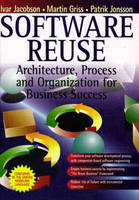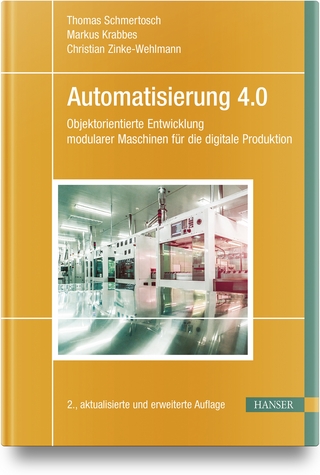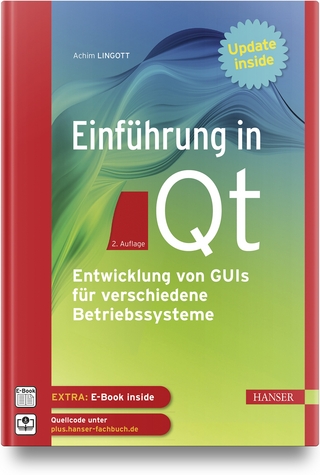
Software Reuse
Addison Wesley (Verlag)
978-0-201-92476-3 (ISBN)
- Titel ist leider vergriffen;
keine Neuauflage - Artikel merken
"How can I incorporate reuse into my complex software development process in order to gain a competitive edge?"
This is a question that many have attempted to answer by taking up object technology, with varying degrees of success. In Software Reuse: Architecture, Process and Organization for Business Success , the authors present a brand new, technically innovative, coherent and systematic model for implementing reuse. They have combined their experience in the fields of object oriented software engineering, business engineering and systematic software reuse to create the Reuse-Driven Software Engineering Business (Reuse Business) framework.
Software Reuse: Architecture, Process and Organization for Business Success
- introduces the concept of software reuse as a business success enable
- describes how the right architecture allows applications and components to evolve gracefull
- provides guidelines for implementing software engineering processe
- advises on organizational issues such as the structure, transition, day-to-day managment, economics and measurement.
Whether you are a software engineer, architect, designer, programmer or manager, whether you are familiar with the concepts of reuse, component-based software engineering, object oriented technology and business engineering or not, you should read Software Reuse: Architecture, Organization and Process for Business Success. In it you will find new ground-breaking information and advice
Visit the Rational Web Site http://www.rational.com
Dr. Ivar Jacobson, Vice President of Business Engineering, is the inventor of the OOSE method, and he is also the founder of Objectory AB in Sweden, which recently merged with Rational Software Corporation. Dr. Jacobson is the principal author of two influential and best-selling books Object-Oriented Software Engineering--A Use Case Driven Approach (Computer Language Productivity award winner in 1992) and The Object Advantage--Business Process Reengineering with Object Technology. He has also authored several widely referenced papers on object technology. One of the most famous papers is his first OOPSLA '87 paper entitled "Object-Oriented Development in an Industrial Environment," which presented the first truly object-oriented method ever published. Ivar Jacobson's use-case driven approachhas had a very strong impact on the entireOOAD industry, and he himself has become one of its "icons." Consequently, he isa frequently invited keynote speaker and panelist, debating OOAD topics withcolleagues and methodologists such as Grady Booch, Jim Rumbaugh, StevenMellor, and Rebecca Wirfs-Brock at major OO conferences around the world. He is well known for his pioneering work and more than 20 years of experience inusing object methods for the design of large real-time systems. His earlyobject-based design technique has evolved into the international standardITU(formerly CCITT)/SDL. Dr. Jacobson also regularly serves on the OOPSLA, ECOOP, and TOOLSprogram committees, and he is a member of the advisory board of the Journal ofObject-Oriented Programming. In 1994, Ivar Jacobson received the first Swedish Computer Association (SCA)award (the Kjell Hultman prize) for "extraordinary achievement in promotingefficiency and productivity in the development and use of informationtechnology." Martin Griss is a Senior Laboratory Scientist at Hewlett Packard Laboratories where, as HP's "Reuse Rabbi", he created the Corporate Reuse Program and led HP's technical contributions as co-submittor of UML to the OMG. He also writes a reuse column for Object Magazine and is active on several reuse program and steering commitees. Patrik Jonsson works at Rational Software Corporation in Sweden as a Senior Consultant where he has been developing the architecture and method of the Objectory process with a current focus on reuse and user interface development. 0201924765AB04062001
Preface
Systematic software reuse
What is this book about?
Who needs a Reuse-Driven Software Engineering Business?
The essence of the Reuse-Driven Software Engineering Business
Our experience
How this book is organized
What this book offers
Acknowledgments
Dedications
PART I - INTRODUCING THE REUSE-DRIVEN SOFTWARE ENGINEERING BUSINESS
1. Software Reuse Success Factors
1.1 Software reuse is a simple idea
1.2 Components are fueling a revolution in application development
1.3 A systematic approach makes pragmatic reuse work
1.4 Ericsson and Hewlett-Packard reuse experience reveals common principles
1.5 Reuse requires changes in process
1.6 Reuse requires changes in organization
1.7 Adopt reuse systematically and incrementally
1.8 Input from other reuse programs
1.9 It takes a set of principles
1.10 Summary
2. Reuse-Driven Software Engineering Is A Business
2.1 Is it a business for you?
2.2 Make reuse cost-effective
2.3 A Reuse Business has business characteristics
2.3 Architect components and applications
2.4 Software engineering processes
2.5 Establishing and managing a reuse business
2.6 Summary
PART II - ARCHITECTURAL STYLE
3. Object-Oriented Software Engineering
3.1 Software engineering transforms requirements into code
3.2 Software engineering is a team process
3.3 Software engineering is systematic model building
3.4 Objects unify the modeling process
3.5 The use case model captures system requirements
3.6 The analysis model shapes system architecture
3.7 The design model defines the implementation
3.8 The implementation model is the code
3.9 The test model validates the system
3.10 Summary
4. Application And Component Systems
4.1 Application developers can reuse OOSE model components
4.2 Application families allow significant reuse
4.3 Application systems are built from reusable components
4.4 Group components into component systems
4.5 Facades control access to component system internals
4.6 Facades and component systems are special kinds of packages
4.7 Component systems export components via facades
4.8 Specialize some components before reuse
4.9 Variability occurs at variation points
4.10 Use several kinds of variability mechanisms
4.11 Reuse variable components to build application systems
4.12 Package and document component systems for reuse
4.13 Summary
5. Use Case Components
5.1 Structure the use case model to ensure component reuse
5.2 The use case model shapes the rest of the system
5.3 Reusing components to build the use case model
5.4 Design the use case components for effective reuse
5.5 Not all use cases should be reusable components
5.6 Reusing concrete or abstract actor and use case components
5.7 Expressing use case variability
5.8 Packaging and documenting use case components
5.9 Summary
6. Object Components
6.1 Object models define system architecture and design
6.2 Reusing analysis and design components
6.3 Expressing variability in object model components
6.4 Tracing use case variability to the object models
6.5 Reusable analysis components
6.6 Subsystem components group related classes
6.7 Reusable design and implementation components
6.8 Packaging and documenting object components and variants
6.9 Summary
7. Layered Architecture
7.1 Architecture defines system structure, interfaces and interaction patterns
7.2 A good architecture is crucial to maintain system integrity
7.3 A layered architecture organizes software according to generality
7.4 A layered architecture reduces software dependencies
7.5 The middleware layer supports distributed object computing
7.6 The business-specific layer supports rap
| Erscheint lt. Verlag | 6.7.1997 |
|---|---|
| Reihe/Serie | Object Technology Series |
| Verlagsort | Harlow |
| Sprache | englisch |
| Maße | 180 x 243 mm |
| Gewicht | 890 g |
| Themenwelt | Informatik ► Software Entwicklung ► Objektorientierung |
| Wirtschaft ► Betriebswirtschaft / Management ► Logistik / Produktion | |
| ISBN-10 | 0-201-92476-5 / 0201924765 |
| ISBN-13 | 978-0-201-92476-3 / 9780201924763 |
| Zustand | Neuware |
| Haben Sie eine Frage zum Produkt? |
aus dem Bereich


